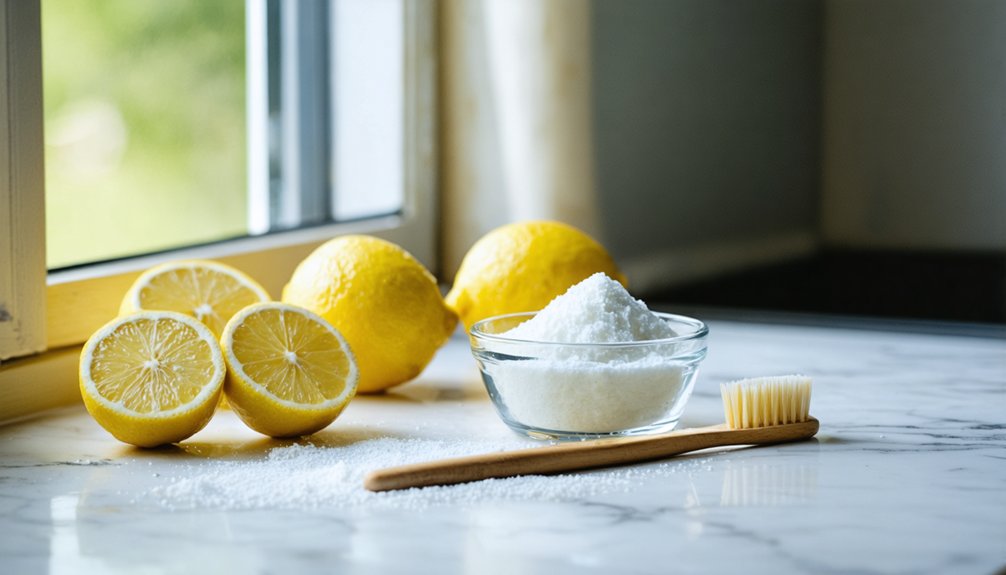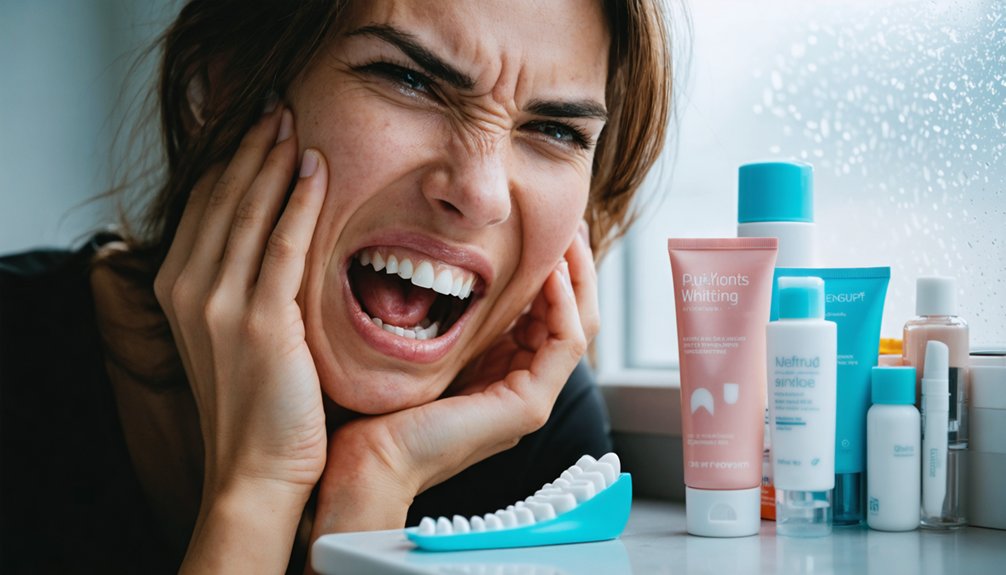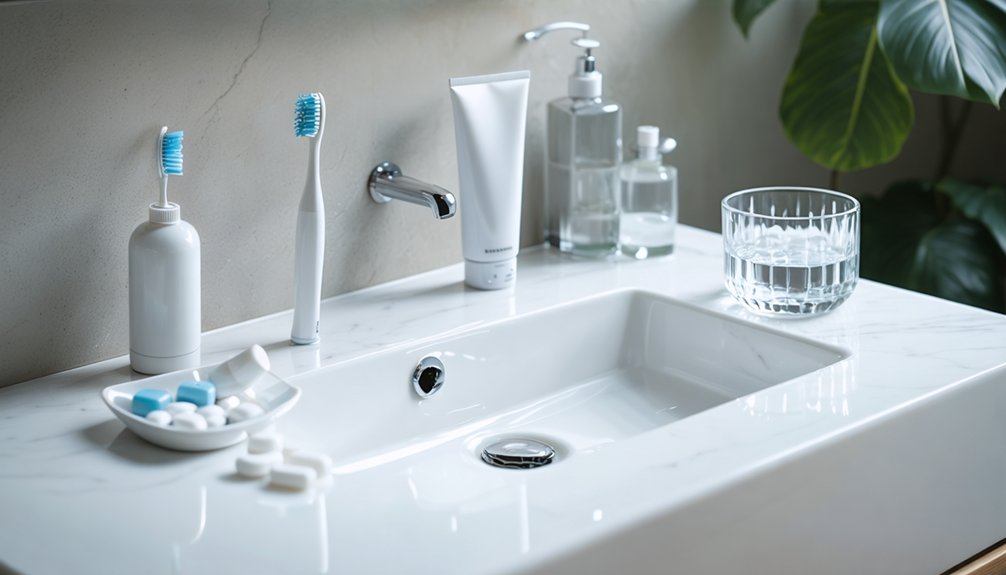You can safely whiten sensitive teeth using specialized products with lower peroxide concentrations and desensitizing agents. Start with gentle over-the-counter options like Crest 3D Whitestrips for sensitive teeth, or consider professional treatments that offer controlled application methods. Pre-treatment dental cleaning and assessment help optimize results while minimizing discomfort. For best results, combine whitening with sensitivity-focused toothpaste and fluoride rinses. Understanding proper techniques and products will help you achieve a brighter smile without compromising comfort.
Key Takeaways
- Professional whitening treatments with low-peroxide formulations (10-16%) combined with desensitizing agents offer safer results for sensitive teeth.
- Over-the-counter products like Crest 3D Whitestrips feature gentler formulations specifically designed for sensitive teeth.
- Natural alternatives such as baking soda or coconut oil provide mild whitening effects with minimal sensitivity risks.
- Custom-fitted trays with 10% peroxide gels allow precise application and controlled exposure for sensitive teeth.
- Using desensitizing toothpaste and fluoride rinses before and during whitening treatment helps minimize discomfort.
Understanding Teeth Sensitivity and Whitening
While teeth whitening remains a popular cosmetic treatment, understanding its relationship with tooth sensitivity is vital for safe and effective results.
If you’re among the one in eight Americans experiencing tooth sensitivity, you’ll need to approach whitening with extra caution. Your teeth may react painfully to the whitening agents, especially if you have worn enamel or receding gums. Cold winter months can intensify sensitivity during whitening treatments.
Whitening products can temporarily increase sensitivity by penetrating the dentin layer of your teeth. Regular use of fluoride rinse and toothpaste can help strengthen enamel and reduce sensitivity before starting a whitening regimen. You’re more likely to experience these effects with at-home treatments compared to professional procedures.
At-home teeth whitening may cause heightened sensitivity as products penetrate tooth layers deeper than professional treatments typically would.
To minimize discomfort while achieving desired whitening effects, consider using desensitizing products containing potassium nitrate or strontium chloride before and after treatment.
It’s important to consult your dentist first, as they can assess your sensitivity level and recommend the most suitable whitening approach.
Pre-Treatment Assessment and Safety Checks
Before starting any teeth whitening treatment, a thorough pre-treatment assessment offers critical safeguards against potential complications. Your dentist will conduct a detailed pre-treatment evaluation to examine your oral health status, medical history, and sensitivity levels. The dentist must carefully consider any existing restorations since they will not change color during the whitening process. Professional treatments use stronger peroxide concentrations that require expert supervision for safe application.
Safety considerations include checking for existing dental work, tooth decay, and gum disease that could affect treatment outcomes.
- A detailed medical history review identifies potential risks, especially if you have heart conditions or take medications that might interact with whitening agents.
- Professional dental cleaning guarantees ideal contact between whitening agents and tooth surfaces while reducing irritation risks.
- Baseline sensitivity testing helps determine your treatment protocol and predicts likelihood of post-treatment discomfort.
These assessments empower your dental professional to customize a whitening approach that prioritizes both safety and effectiveness while minimizing sensitivity risks.
Gentle Whitening Products for Sensitive Teeth
When choosing teeth whitening products for sensitive teeth, you’ll find effective options ranging from specialized over-the-counter toothpastes and strips to professionally supervised treatments with reduced peroxide concentrations.
Products like Crest 3D Whitestrips feature lower peroxide levels to minimize discomfort while still providing whitening benefits. Your dentist can recommend customized low-peroxide solutions that combine gradual whitening with desensitizing agents to protect your enamel. For optimal safety and results, any underlying dental issues should be addressed before beginning a whitening regimen.
For those seeking the gentlest approach, natural alternatives like baking soda or coconut oil pulling can provide mild whitening effects while minimizing sensitivity risks.
Over-the-Counter Sensitivity Solutions
Since sensitive teeth require special care during whitening, over-the-counter products now offer gentler formulations with lower peroxide concentrations and desensitizing ingredients. Proper dental cleaning beforehand ensures optimal whitening results with minimal discomfort. Professional guidance recommends using LED light systems to enhance whitening while minimizing sensitivity.
When choosing sensitivity management solutions, look for products containing potassium nitrate and fluoride, which help block nerve pain and strengthen enamel.
You’ll find specially designed whitening strips, toothpastes, and natural kits that prioritize gentle yet effective results.
- Crest 3D White Whitestrips Gentle Routine provides gradual whitening with reduced peroxide concentrations over a 30-day period
- Sensodyne Extra Whitening Toothpaste combines daily whitening action with proven desensitizing ingredients
- Natural alternatives like Oral Essentials Lumineux use plant-based ingredients instead of peroxide for minimal irritation
Always follow product instructions carefully and consider using desensitizing treatments before starting any whitening regimen to maximize comfort and results.
Professional Low-Peroxide Options
Professional whitening solutions offer specialized low-peroxide formulations tailored for patients with sensitive teeth.
You’ll find that dentists typically recommend low concentration gels containing 10-16% hydrogen peroxide, carefully balanced with desensitizing ingredients like potassium nitrate and fluoride to protect your enamel.
These professional options include both in-office treatments and take-home kits. A proper pH range 5.5-10.5 ensures optimal safety and comfort during the whitening process.
In-office systems like GLO Science PRO use controlled heating technology with 24-30% peroxide for brief 16-minute sessions, minimizing discomfort while maintaining effectiveness. These advanced systems provide up to 12 shades whiter results in a single treatment.
For at-home use, your dentist can provide custom-fitted trays with 10% peroxide gels, allowing precise application that limits gum exposure.
The pH-neutral formulations prevent enamel etching, while ingredients like glycerin help maintain ideal moisture levels during treatment.
Natural Whitening Methods
For individuals with sensitive teeth, natural whitening methods offer gentler alternatives to harsh chemical treatments. When exploring natural remedies, oil pulling with coconut oil provides a safe option that won’t increase sensitivity, though its whitening effects aren’t scientifically proven.
Your dietary choices play an essential role in maintaining whiter teeth without compromising sensitivity.
- Practice oil pulling with coconut oil for 15-20 minutes daily to help reduce bacteria and plaque buildup.
- Incorporate high-fiber fruits and vegetables into your diet to naturally clean teeth surfaces while chewing.
- Wait 30 minutes after consuming acidic or staining foods before brushing to protect your enamel.
Avoid abrasive DIY treatments like baking soda pastes, activated charcoal, or acidic fruits, as these can worsen sensitivity and damage enamel.
Instead, focus on preventive measures and gentle, ADA-approved whitening products designed for sensitive teeth.
Natural and DIY Whitening Methods

Natural whitening methods offer gentler alternatives for people with sensitive teeth who want to brighten their smile without harsh chemicals.
Oil pulling with coconut oil provides a safe daily practice that can reduce bacteria and plaque while protecting your enamel. Simply swish one tablespoon of melted coconut oil for 15-20 minutes to maintain oral hygiene and potentially reduce staining.
Baking soda can help remove surface stains when used carefully, but you’ll need to avoid aggressive brushing that could damage sensitive teeth.
While combining baking soda with hydrogen peroxide creates a whitening paste, it’s safer to use ADA-approved products containing these ingredients.
Skip acidic fruit-based treatments, as they’ll harm your enamel. Instead, focus on prevention by limiting staining beverages and maintaining good oral hygiene habits.
Professional Whitening Options for Sensitive Teeth
If you’re seeking professional teeth whitening with minimal sensitivity, LED-based systems offer a gentler approach by using light activation with lower-concentration peroxide gels.
Custom-fit dental trays provide precise application and reduced gum exposure, making them an excellent choice for patients prone to tooth sensitivity.
Your dentist can supervise the peroxide application process, adjusting concentrations and treatment duration based on your specific sensitivity levels and whitening goals.
LED-Based Whitening Systems
LED-based whitening systems represent a modern approach to professional teeth whitening, combining light-activation technology with peroxide-based gels to accelerate the bleaching process.
While research shows mixed results regarding LED effectiveness, these treatments can produce noticeable color changes during in-office sessions. However, you’ll need professional oversight to manage potential sensitivity issues and guarantee ideal results.
- Treatment sessions typically last 30-60 minutes under careful supervision to monitor tooth sensitivity and guarantee proper light activation.
- Customizable options allow for adjusting gel concentrations and light intensity to accommodate sensitive teeth.
- Post-treatment care includes the use of desensitizing agents and gradual maintenance protocols.
For sensitive teeth, your dentist may recommend using lower concentration gels and incorporating desensitizing treatments before and after the procedure.
This approach helps minimize discomfort while still achieving desired whitening results.
Custom-Fit Dental Trays
Custom-fit dental trays represent a highly effective whitening solution for patients with sensitive teeth, combining professional-grade results with controlled application methods.
These trays are precisely molded to your unique dental structure, ensuring maximum dental comfort and preventing gel leakage that can cause irritation.
Unlike over-the-counter options, custom trays deliver more consistent results, achieving 3-8 shades of improvement while minimizing sensitivity risks.
You’ll benefit from even gel distribution and professional oversight, allowing for treatment adjustments based on your comfort level.
The flexible treatment schedule lets you whiten at home for 30 minutes to several hours daily over 2-4 weeks.
Your dentist will provide detailed instructions and monitor your progress, ensuring safe, effective whitening while protecting sensitive areas from exposure to harsh chemicals.
Supervised Peroxide Application
Professional peroxide application under dental supervision offers a controlled approach to teeth whitening for patients with heightened sensitivity. Your dentist will carefully manage peroxide concentration levels, typically using 25-35% hydrogen peroxide or 10-20% carbamide peroxide, while monitoring your response throughout treatment.
During supervised whitening, your dentist implements specific protocols to minimize discomfort:
- Application of desensitizing agents containing potassium nitrate and fluoride
- Customized treatment plans based on your dental history and sensitivity level
- Immediate adjustments to exposure time or concentration if sensitivity occurs
The process allows for precise control of the whitening procedure while maintaining safety.
Your dentist may recommend combining in-office treatment with take-home options to achieve ideal results while managing sensitivity through professional oversight and appropriate peroxide concentrations.
Post-Whitening Care and Maintenance
After undergoing a teeth whitening procedure, proper maintenance becomes essential for preserving your results and protecting your sensitive teeth.
Your post-whitening diet should focus on light-colored foods like white rice, eggs, and cauliflower while avoiding staining agents such as coffee, tea, and dark sauces for at least 48 hours.
Maintain ideal oral hygiene by gentle brushing with non-abrasive toothpaste and regular flossing.
To manage sensitivity, use fluoride rinses and specialized sensitivity toothpaste. Keep your food and beverages at moderate temperatures, and consider taking over-the-counter pain relievers if needed.
Schedule touch-up appointments every 6-12 months, and use at-home whitening trays as directed by your dentist.
For long-term success, avoid smoking and monitor your teeth’s color stability over time.
Signs to Stop or Modify Your Whitening Routine

Recognizing warning signs during teeth whitening helps prevent damage to your dental health. If you experience persistent sharp pain, gum irritation, or increased sensitivity that lasts beyond a week, it’s essential to stop your whitening routine immediately.
Stop teeth whitening immediately if you notice sharp pain, gum irritation, or prolonged sensitivity to protect your dental health.
Pay attention to your whitening frequency and adjust your schedule to protect your enamel.
- Sharp, shooting pain when consuming hot or cold items indicates potential nerve irritation.
- Visible redness or burning of gums where whitening gel makes contact requires immediate cessation.
- Translucent edges or chalky appearance suggests enamel erosion from over-whitening.
Monitor your teeth’s response and don’t exceed recommended treatment intervals.
If sensitivity persists for more than three days after stopping, consult your dentist. Natural age-related darkening may require adjusting your expectations rather than increasing product use.
Frequently Asked Questions
How Long Should I Wait Between Whitening Treatments if I Have Sensitivity?
Like a gentle tide, you’ll want to space your treatment intervals 7-14 days apart. If you’re experiencing heightened sensitivity, extend duration between sessions to 3-4 weeks for comfort.
Can Certain Medications Affect Tooth Sensitivity During Whitening Procedures?
Yes, medications like antihistamines, antibiotics, antacids, and corticosteroids can considerably increase your sensitivity levels during whitening. You’ll want to inform your dentist about all medications you’re currently taking.
Are There Specific Foods That Can Reduce Tooth Sensitivity While Whitening?
You’ll reduce tooth sensitivity by eating dairy products, soft foods, and whitening fruits like peeled apples. Choose lukewarm, neutral-colored options and avoid acidic or dark-staining foods during treatment.
Does Age Impact How Sensitive Teeth React to Whitening Treatments?
Your age-related sensitivity increases with time as enamel thins, making teeth more reactive to whitening treatments. You’ll need gentler products and shorter application times to maintain whitening effectiveness safely.
Can Previous Dental Work Affect Which Whitening Methods Are Safe to Use?
Like a blueprint guiding construction, your dental history shapes whitening compatibility. You’ll need professional evaluation of restorations, as they won’t whiten evenly and could weaken with standard treatments.
References
- http://www.goochlanddentistry.com/whats-the-best-teeth-whitener-for-sensitive-teeth/
- https://pmc.ncbi.nlm.nih.gov/articles/PMC4058574/
- https://www.sensodyne.com/en-us/oral-health-tips/whitening-sensitive-teeth/what-to-know/
- https://www.drbobsdentalcare.com/is-teeth-whitening-safe-for-sensitive-teeth/
- https://www.parkcreekdentalcare.com/blog/teeth-whitening-for-sensitive-teeth-safe-options-that-work/
- https://www.44thstdental.com/how-to-whiten-sensitive-teeth/
- https://harborcreekdental.com/whitening-sensitive-teeth-what-you-need-to-know/
- https://www.snc.dental/blog/how-to-safely-whiten-sensitive-teeth/
- https://healthcare.utah.edu/healthfeed/2023/12/perils-of-sensitive-teeth
- https://www.glaciercreekdental.com/tooth-sensitivity-1-in-8-americans-have-it/



